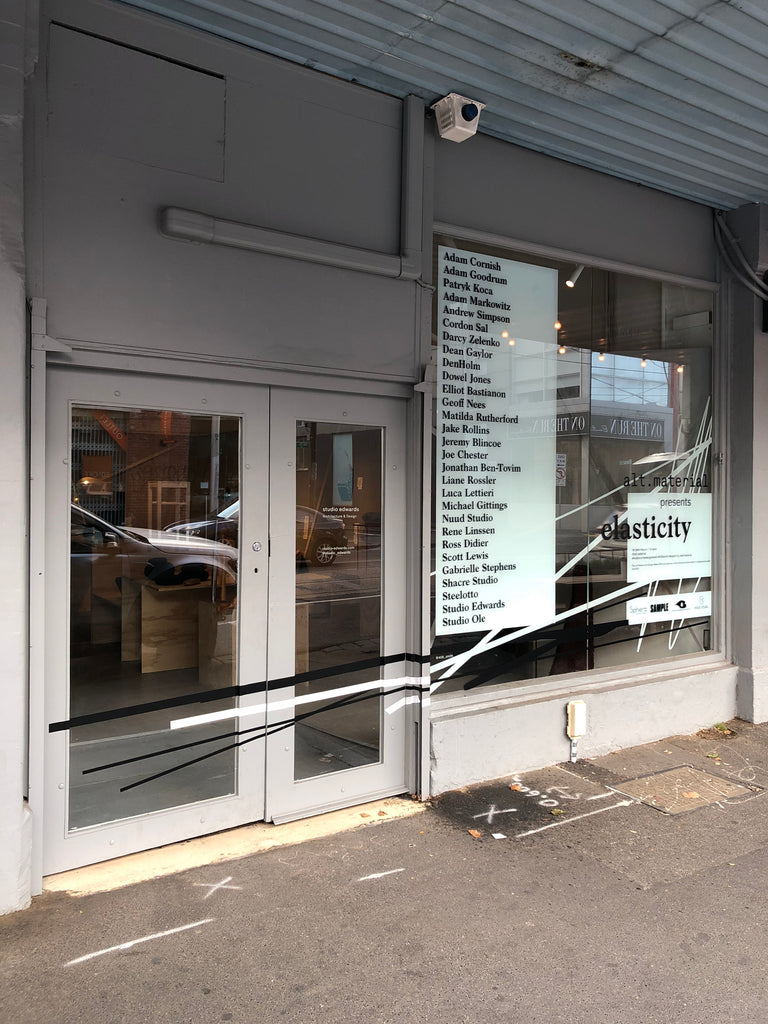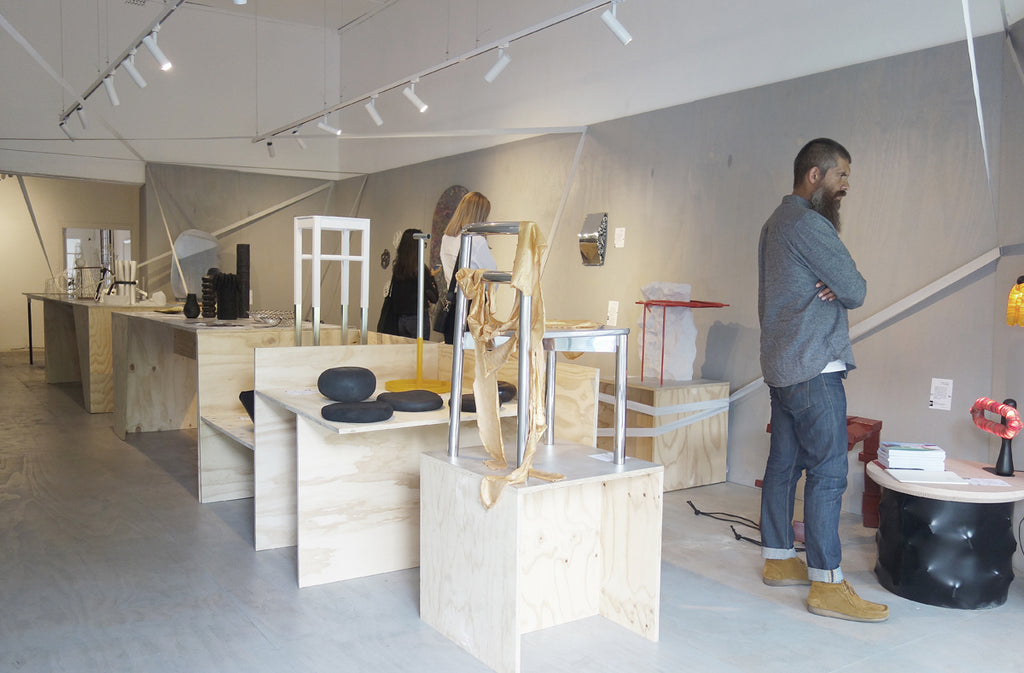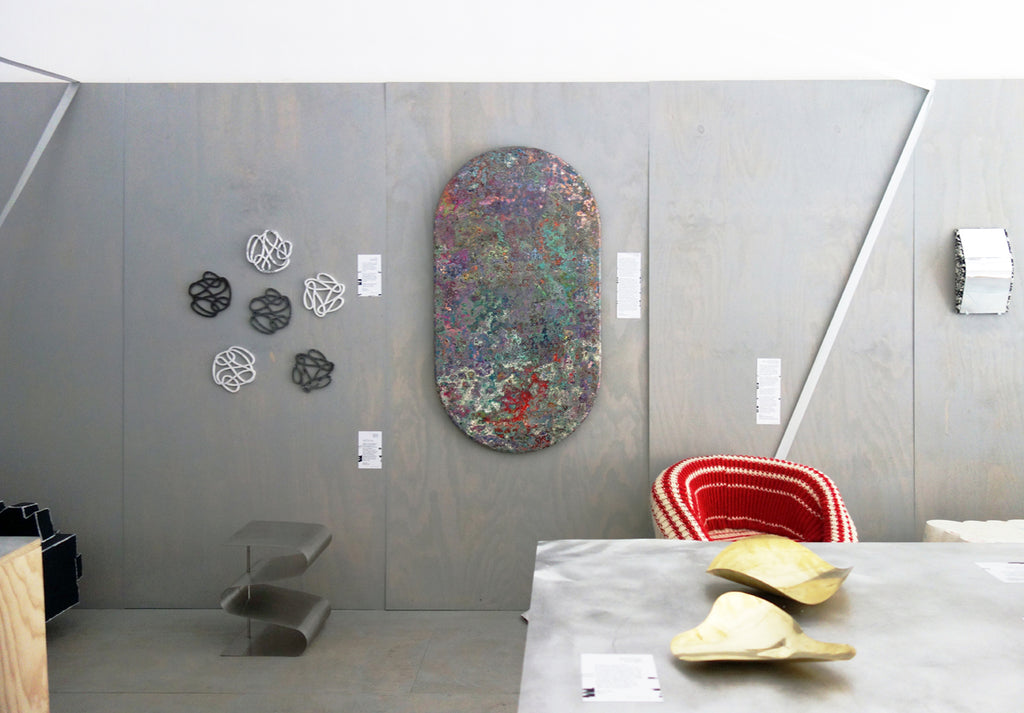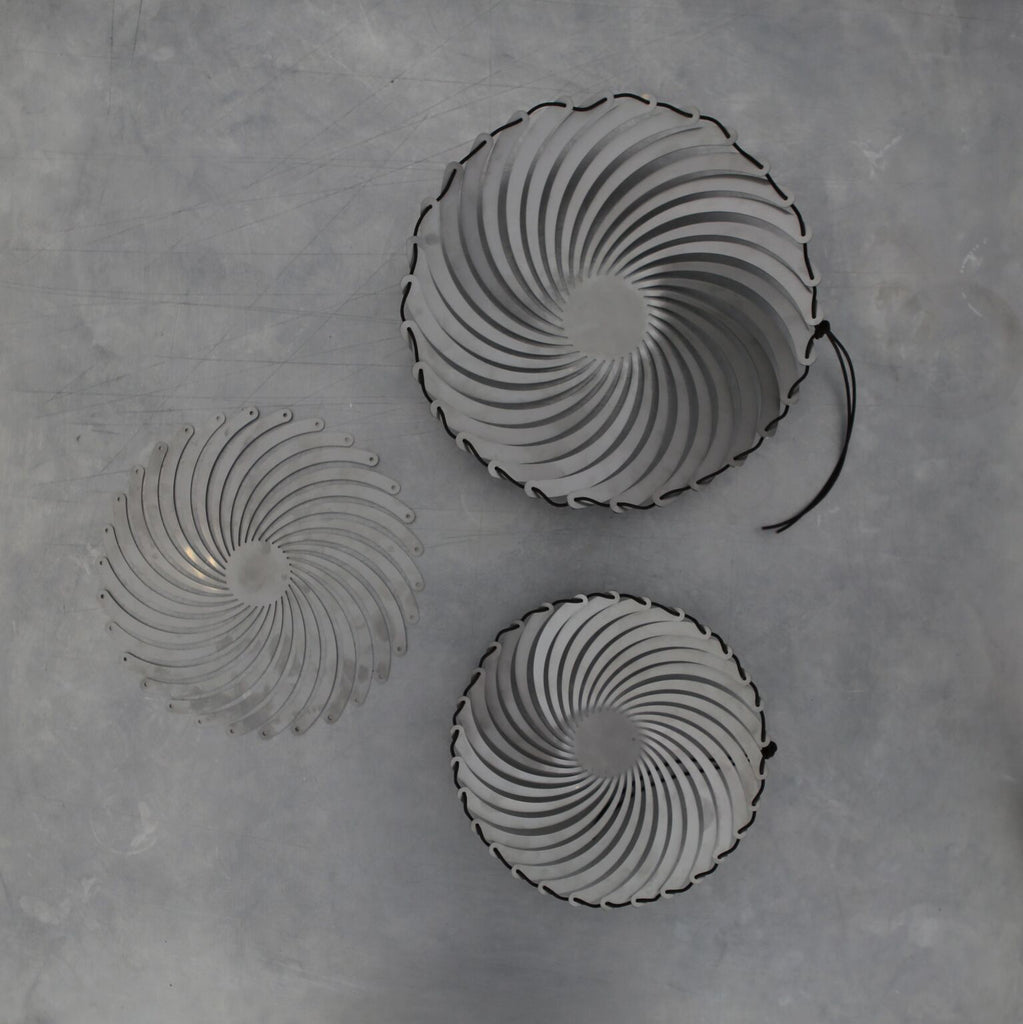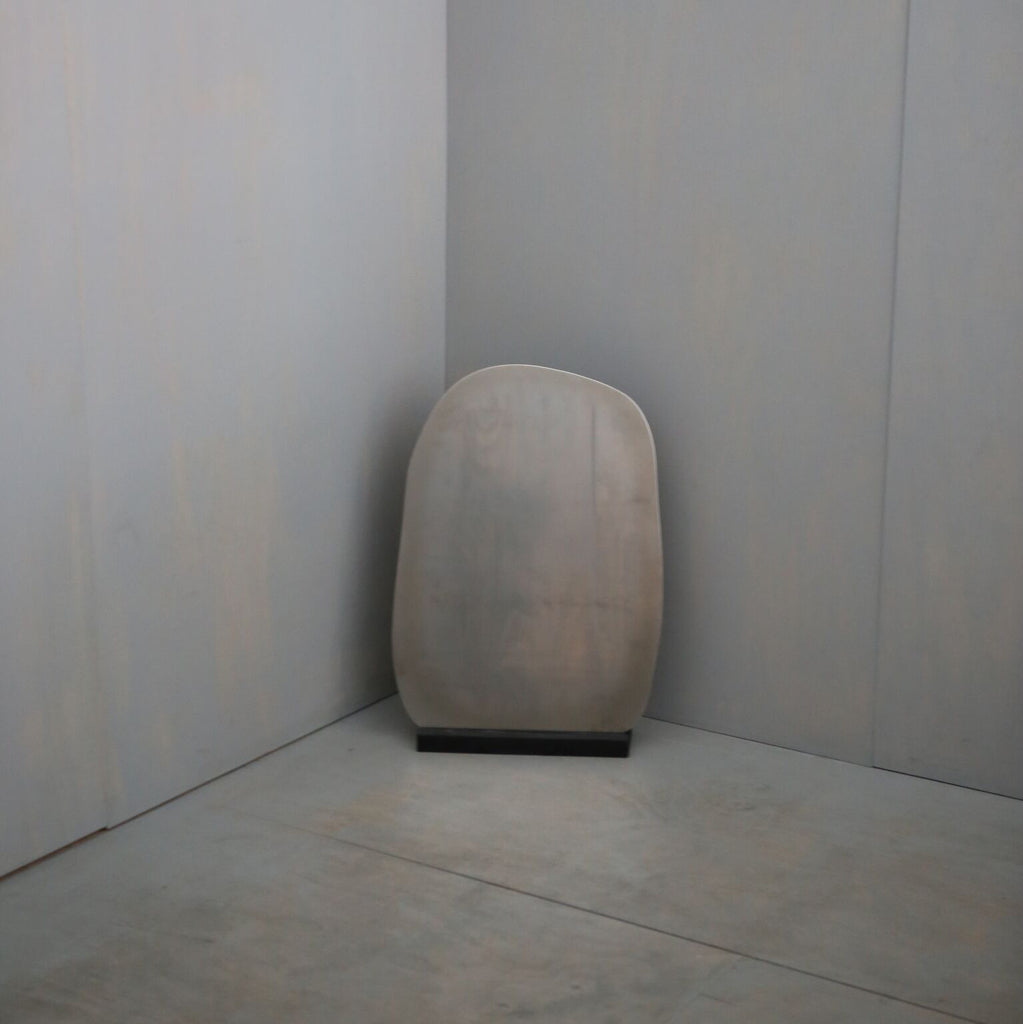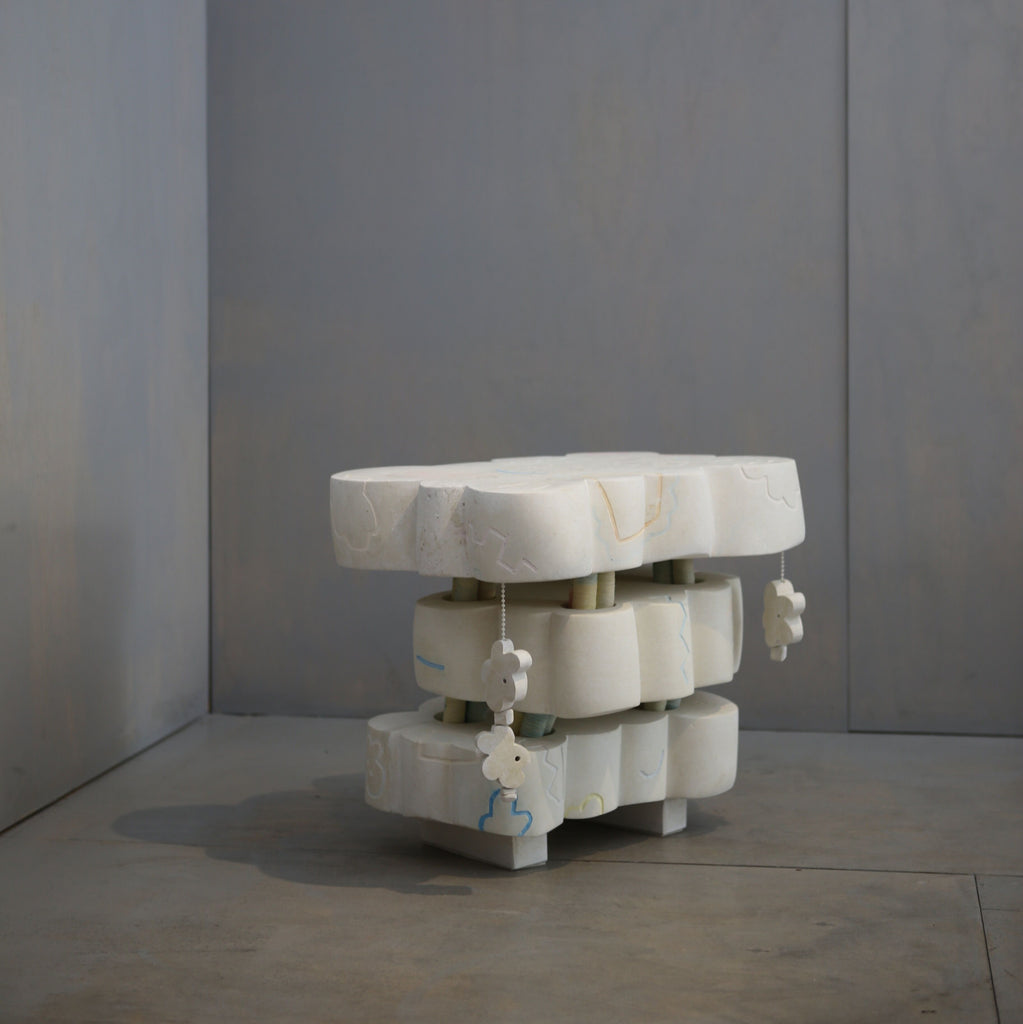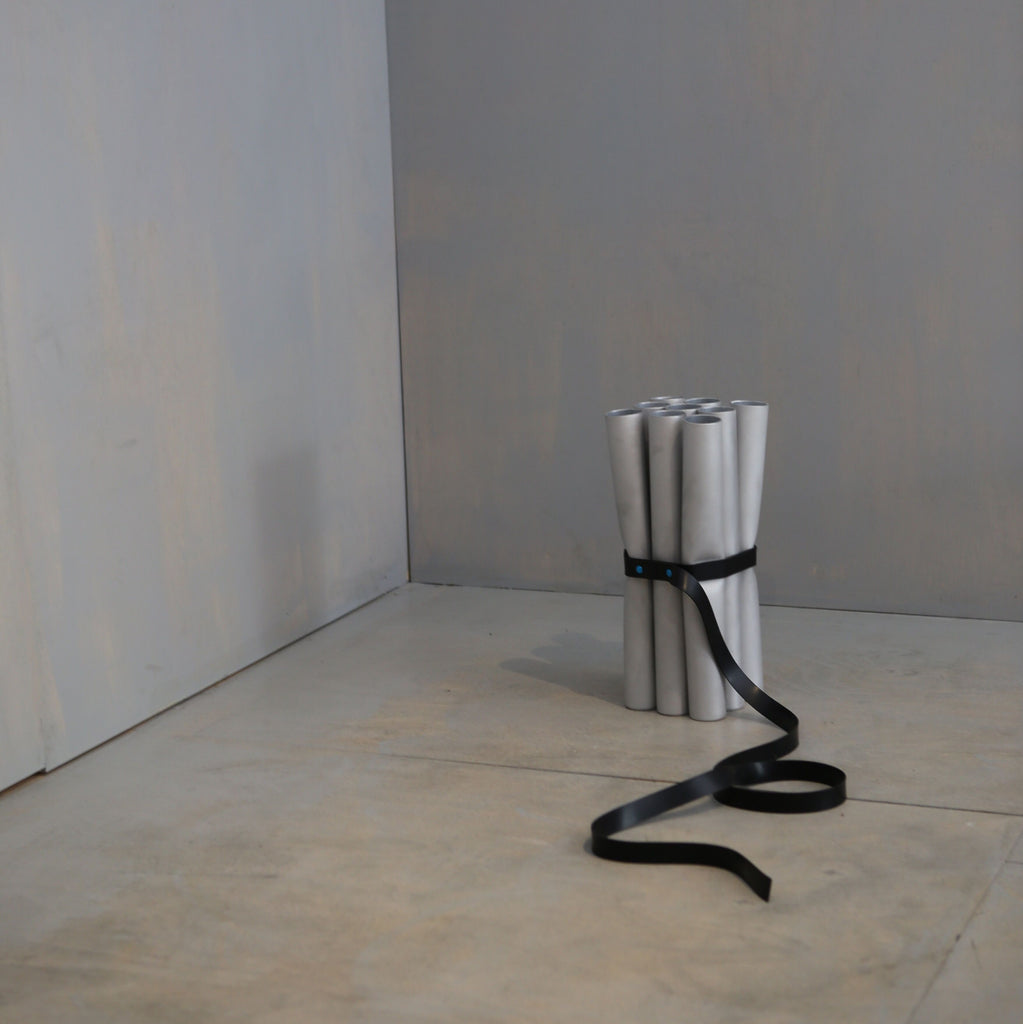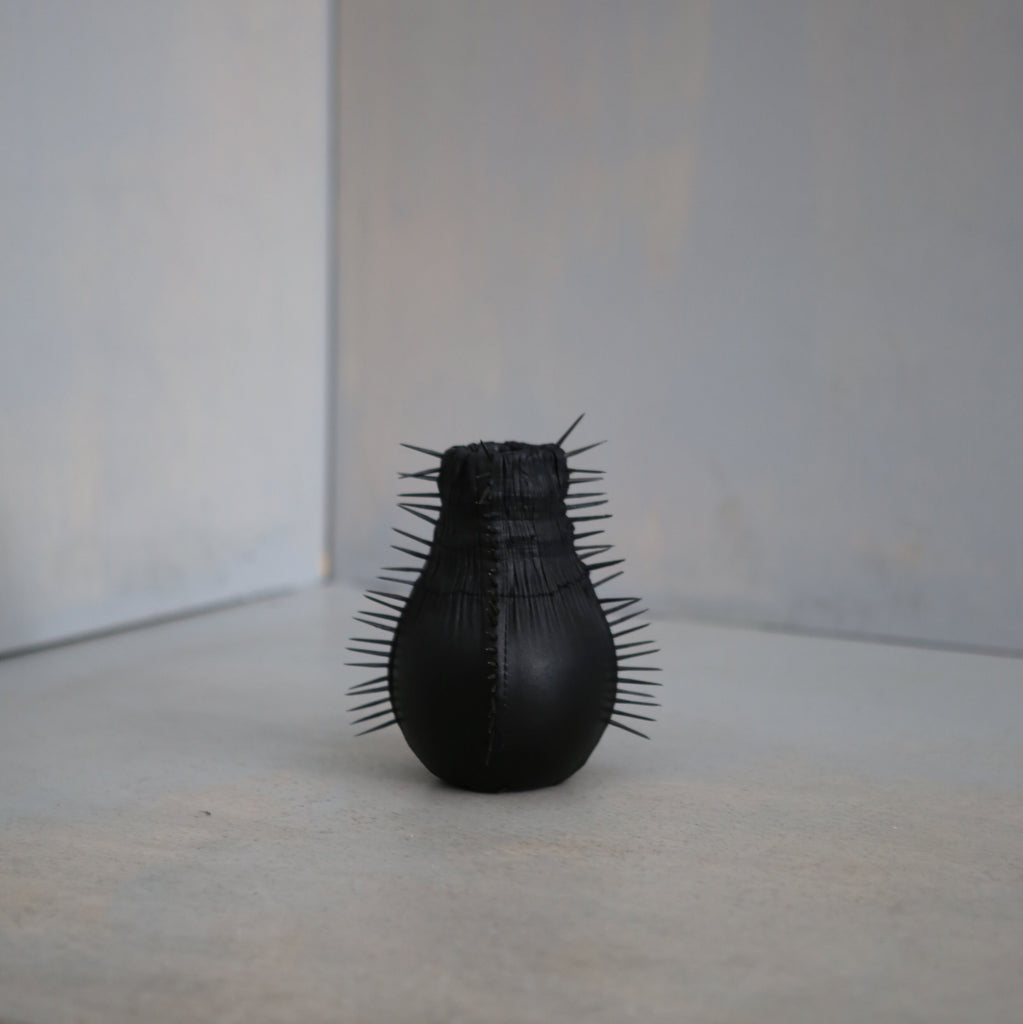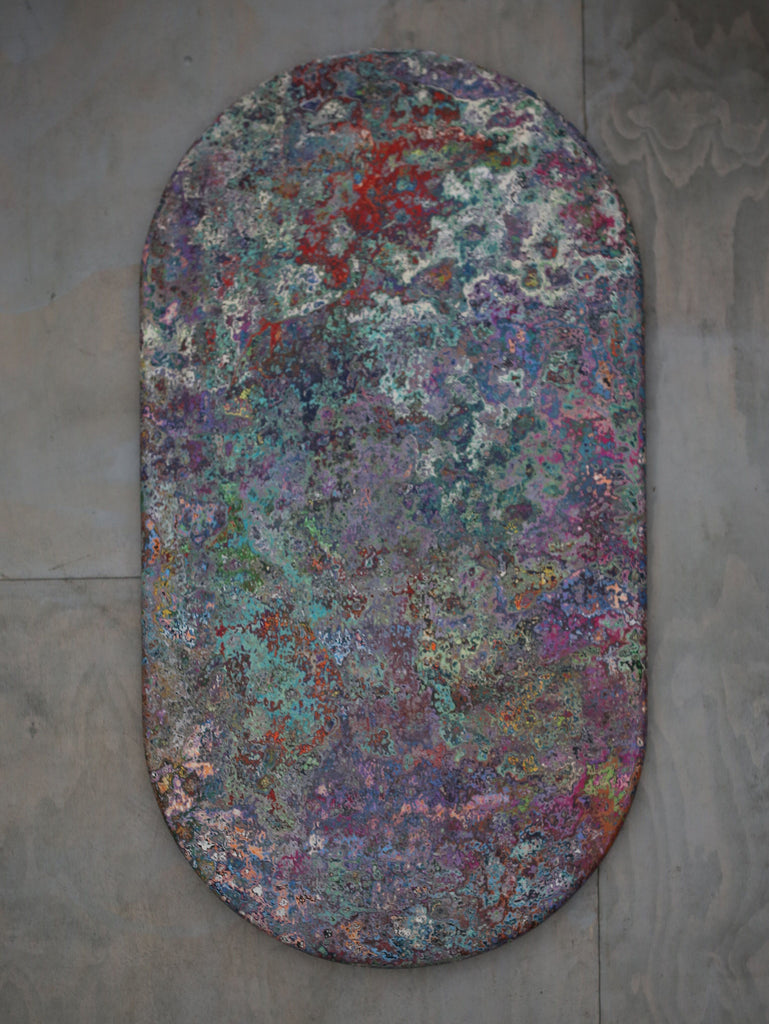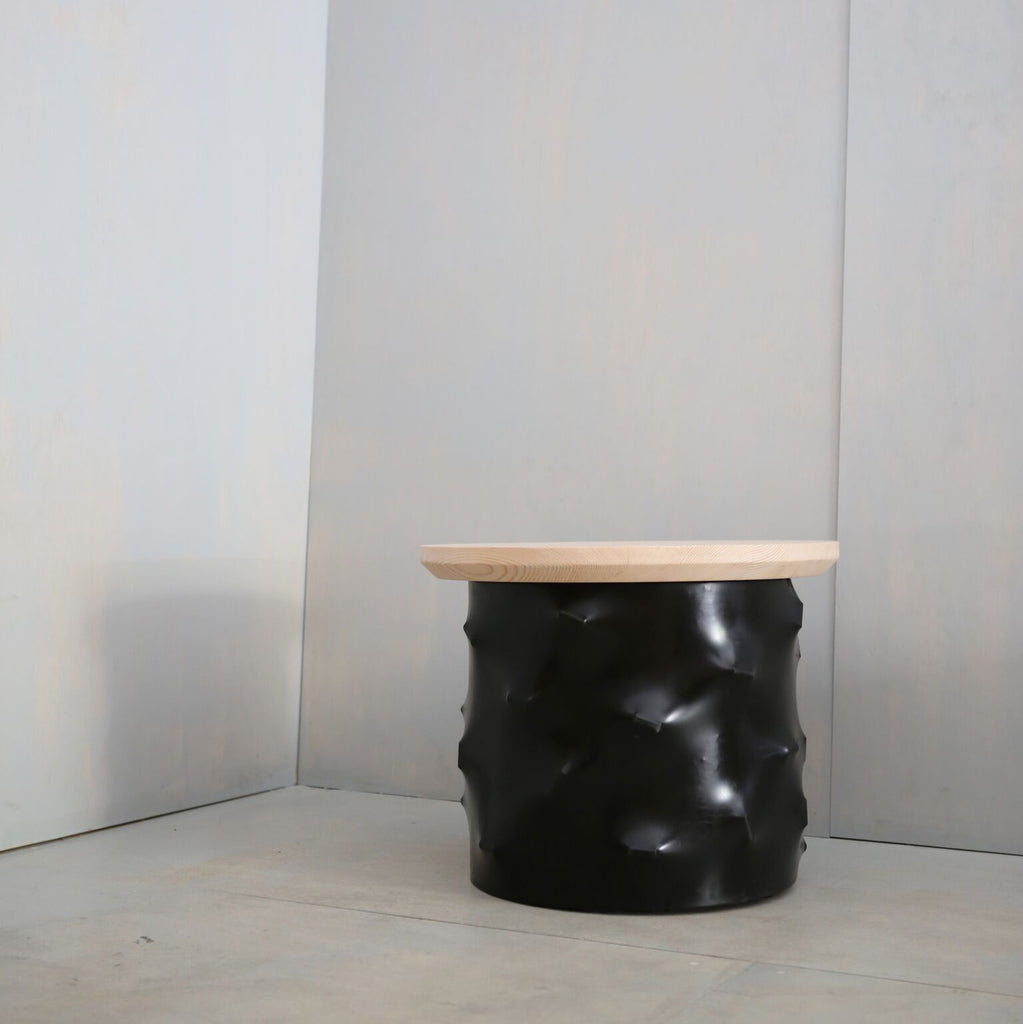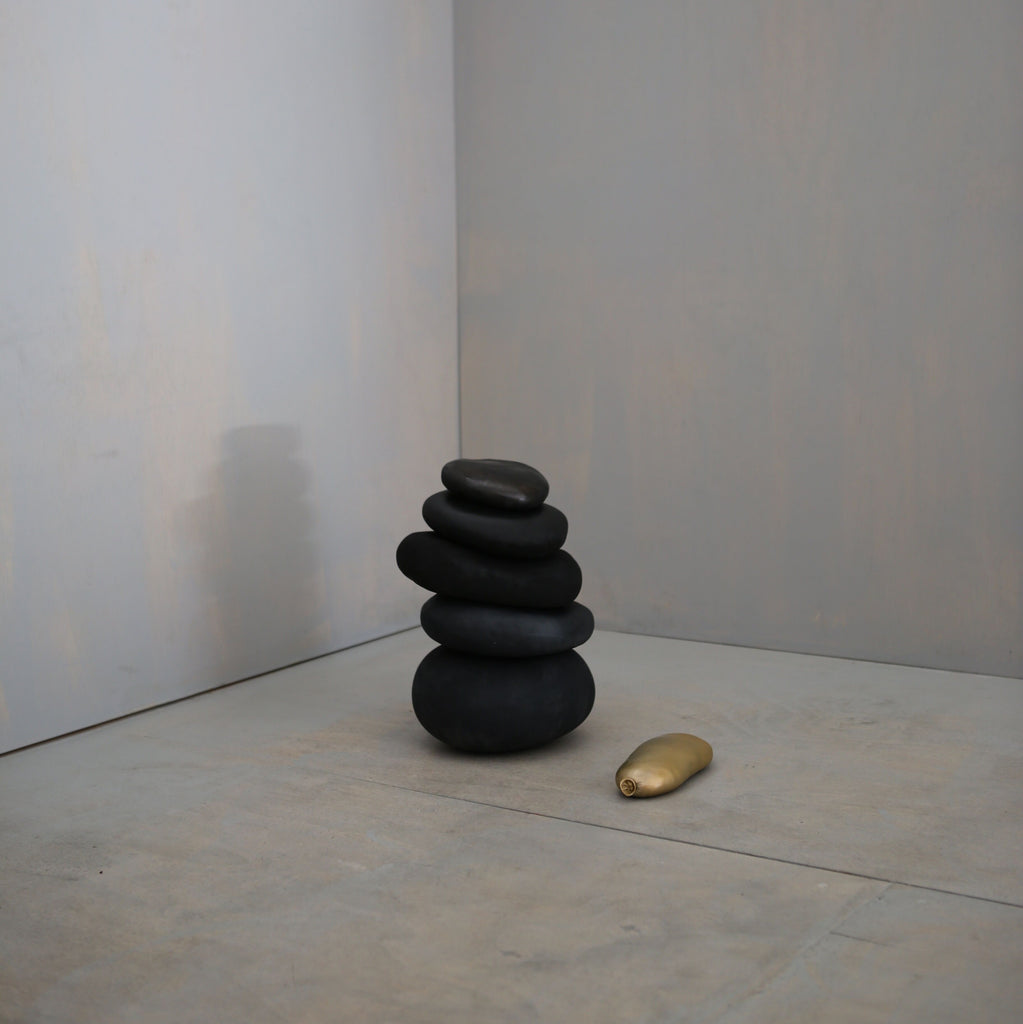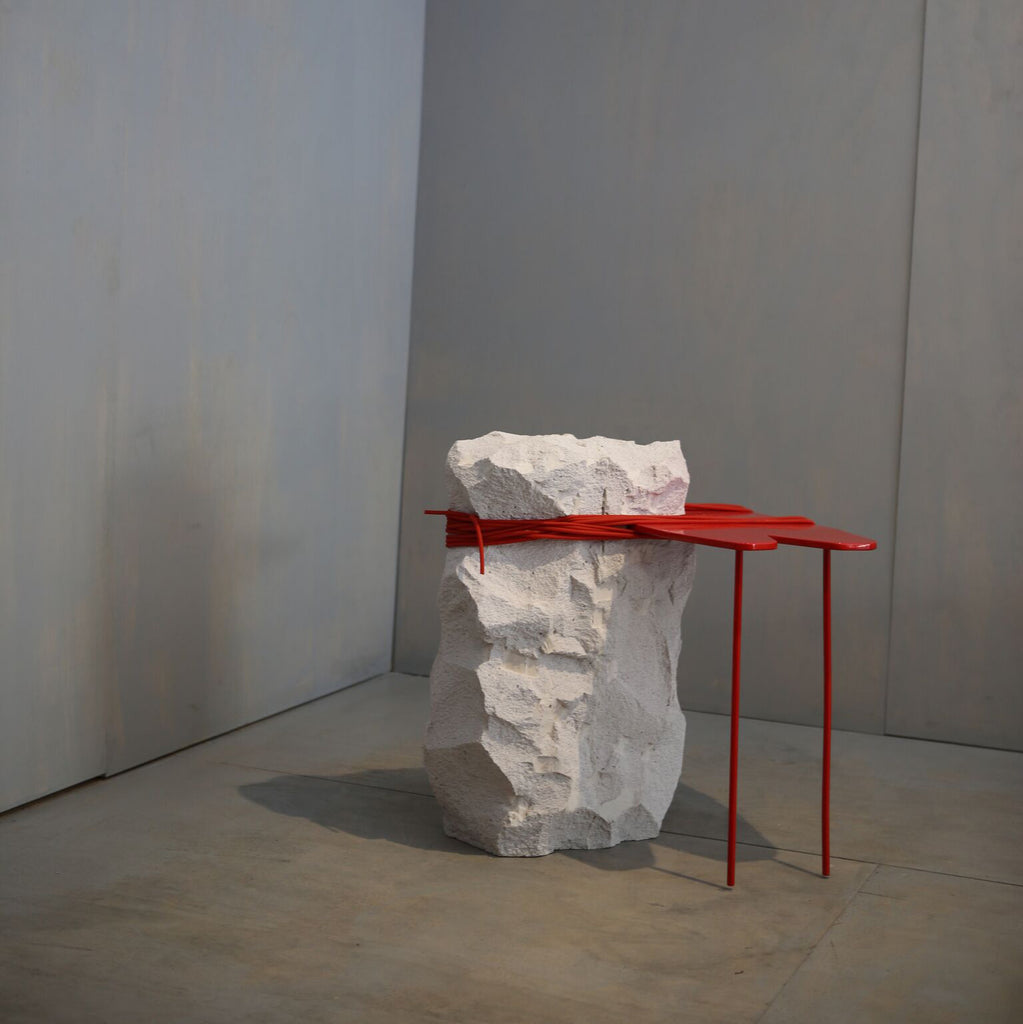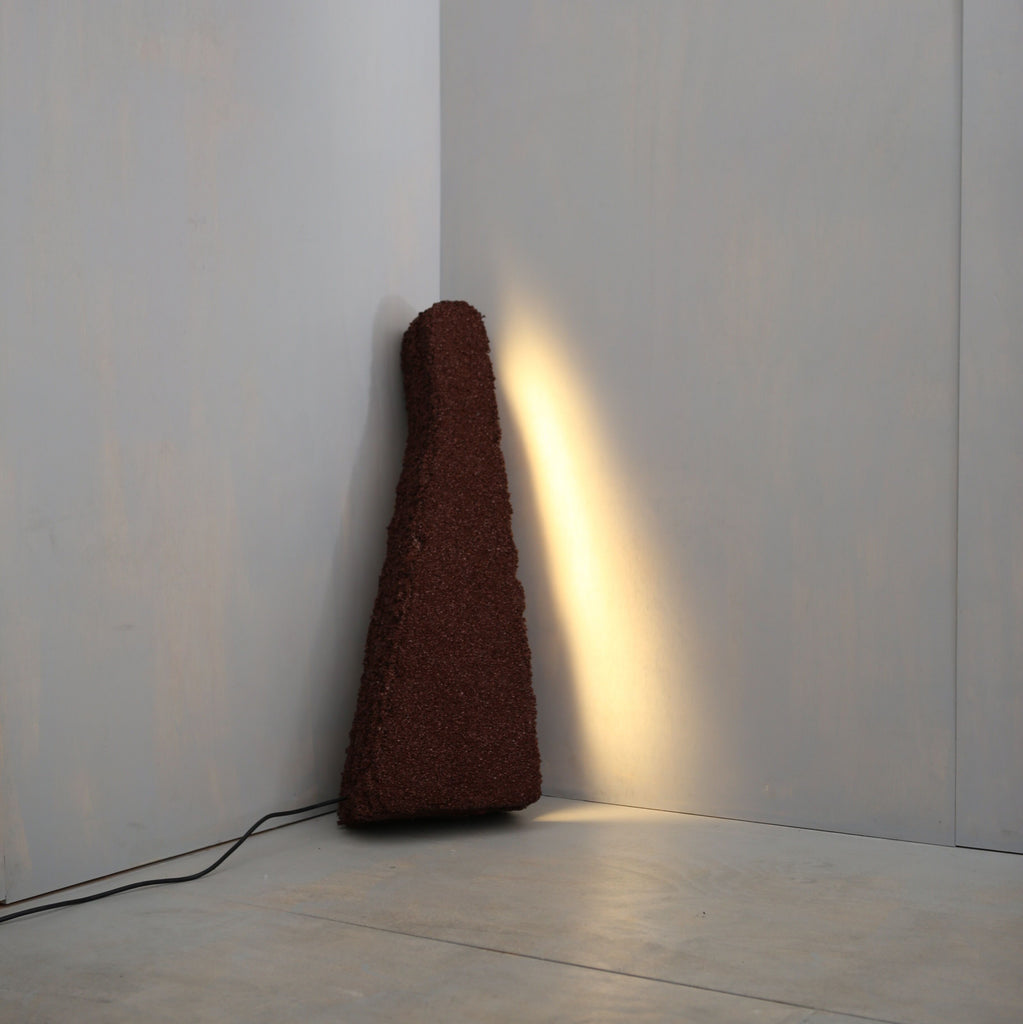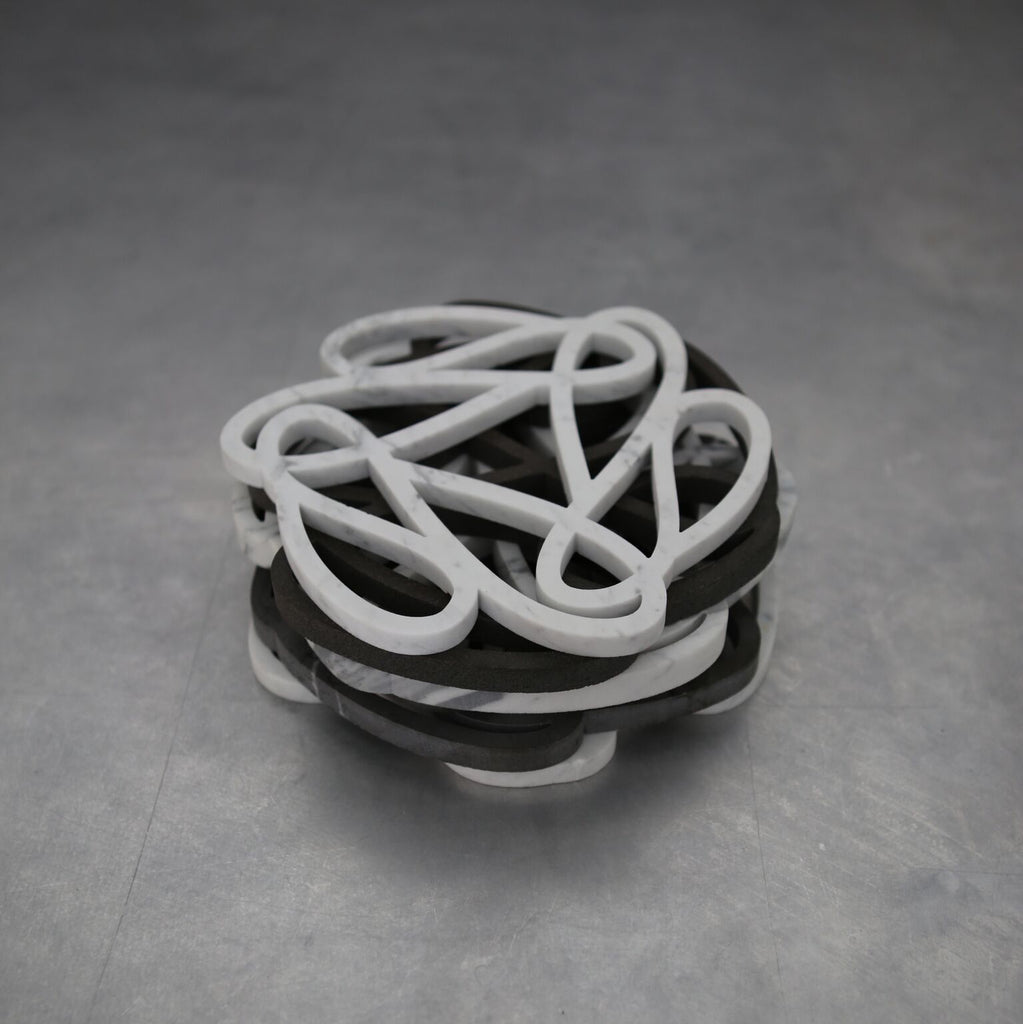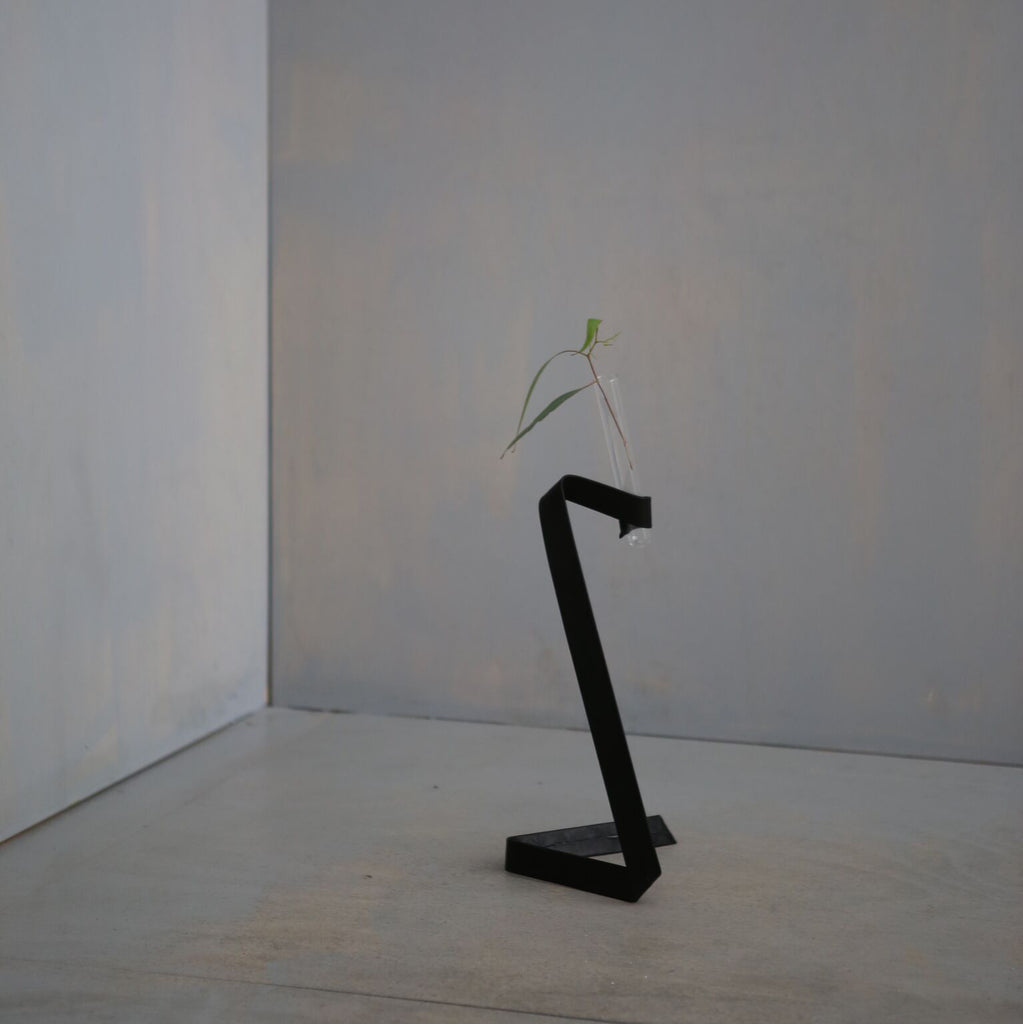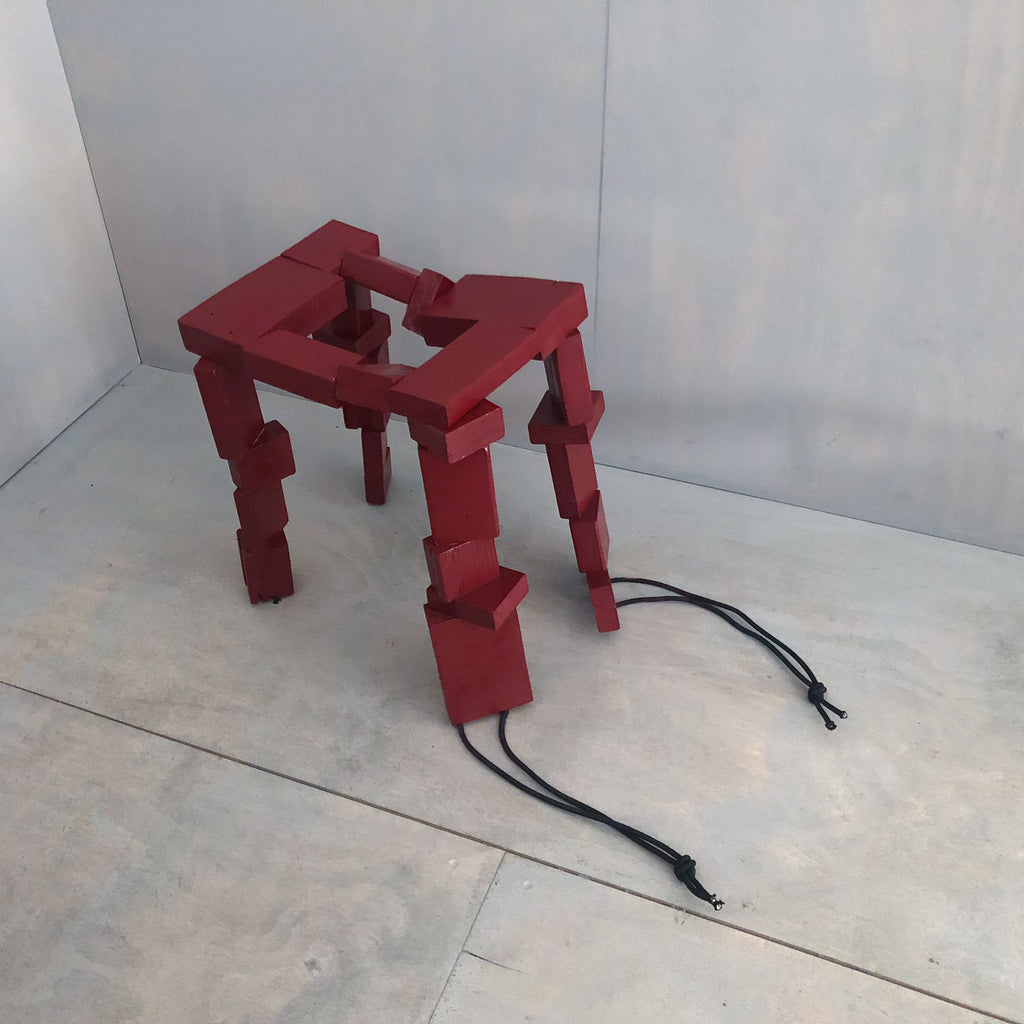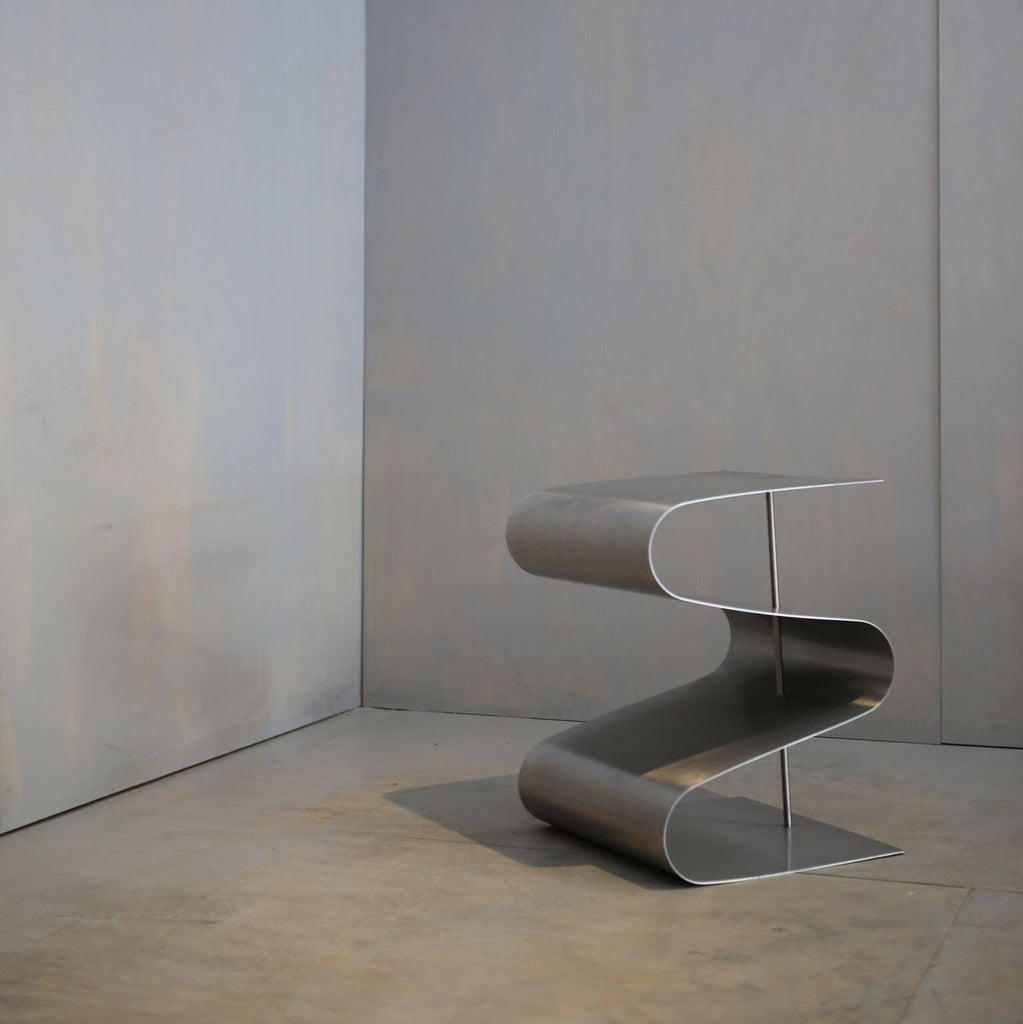Elasticity
2019
Elasticity builds on the first show in 2018 and forms part of an ongoing body of work within the alt.material collective. Inviting leading designers to create prototypes and experimental works in response to the theme ‘elasticity’ and shown as part of NGV Melbourne Design Week.
Photography: Bao Vo
Sunny Centrepiece / Adam Cornish
The Sunny Centrepiece was designed to exploit the spring like quality of stainless steel. The relief pattern is laser cut with the intention of allowing the structure to flex. The sun like array of arms are pulled up into position using a leather drawstring. The design uses the elastic tension to turn a flat two dimensional shape into a vessel capable of storing fruit and other produce. Materials (Stainless Steel & Leather)
Knit One Purl One / Adam Goodrum & Patryk Koca
Knitting creates multiple loops of yarn in a line and consecutive rows of these intermeshing loops create knitted fabric, producing loose yet extremely elastic fabrics with almost vanishing rigidity. Ribbing is a knitting pattern resulting from vertical columns of knit and purl stitches. It is the most elastic of knitting patterns, but the elasticity depends on the number of knit/purl repetitions. Ribbing with a ‘knit one, purl one’ repetitive pattern holds the most elasticity. Today we rely on mechanically knitted materials, hand knitting has been relegated to a hobby in the wake of industrialisation, despite being a thousand-year-old technology. We were inspired by this re-surging craft, the adaptability of knitted materials and the availability of ecologically conscious raw material. Using sustainably sourced Eco-Wool we created an easy chair – sheathed in a giant ribbed tube, hand knitted by Wanda Gierzynska on large needles using bulky yarn. The tube stretches tightly over some of the underlying structure, while falling loosely elsewhere, contributing to the overall form of the chair. Materials (Millennium Eco-Wool, Foam Linen-Cotton Canvas & Plywood)
Bow Lamp / Adam Markowitz
A delicate lamp that challenges our perception of the natural state of materials. Timber, often associated with permanence and solidity, is twisted, bent and hand carved into a form that leaves it almost unrecognisable as a material. Using a steam chamber the lignin bonds binding the cells of the timber are temporarily made elastic, allowing it to be bent into an arc. The natural tendency of the material to spring back keeps the cable taught, leaving it in a state of perpetual tension, like a drawn bow. Materials (Spotted Gum, LED Bulb, Glass Diffuser, Brass & Marine Braid Cable)
Looking Glass / Cordon Salon
One material in two states. Stainless steel is a material typical utilised in marine and architectural applications due to its resistance to corrosion. Often uniformly manipulated such as brushed, polished, coated or textured. We looked again at how this common material might provide new or additional functions when presented in multiple states. The transitional finish shifts the objects purpose from being merely a reflective surface to a frame the viewer regains control and focus over. In its current state, this object establishes two boundaries of its elastic properties. Over time handling will begin to polish the matt edges, while marring and abrasion begin to dull the reflective centre. The two surfaces gravitate toward one another thus establishing a resting point within the dynamic. Materials (Stainless Steel)
Stretch Trays / Darcy Zelenko
A bespoke sheet metal forming machine was created from a 3-axis CNC router and a traditional dapping tool used in jewellery making. Brass was suspended in a jig to allow the tool indent the material which was then programmed to follow a predetermined path to gradually stretch the brass to form the piece. This was then cut out and allowed to relax into a final form. Materials (Brass)
Pissed cake with earrings and tattoos / DenHolm
Pissed cake with earrings and tattoos explores the personification of the object; the intersect where the natural meets the elasticity of societal influence. Traversing an eclectic stable of purposefully chosen media, the work draws influence from organic forms, the evolution of these forms to a point of uneasiness, and its resulting humanisation. The utilitarian nature of the piece as a stool pushes against its suite of embellishments and apparent instabilities, trading practicality for originality. A departure from industrial efficiencies, Pissed cake with earrings and tattoos is designed to ooze a self depreciating humour, speak with muted sincerity, and entertain like a good host at a party. Materials (Mixed Media: Limestone, Haberdashery, Imitation Pearl, Rubber Composite)
Fun House Mirror / Dowel Jones
Fun House Mirror looks at the elasticity of reflection, using a distortion technique commonly used in circus mirrors. We rely entirely on reflections to view our own faces, so could our mirrors be lying to us? No human alive has viewed their own face with a naked eye, so how do we know what we truly look like? Materials (Acrylic, EVA & MDF)
Squeeze / Elliot Bastianon
‘Squeeze’ is a multi-chambered aluminium vase held together by tensioned rubber. The elastic strip — a softer and secondary material — has caused the aluminium tube to crush and distort around its centre. ‘Squeeze’ comments on the mechanical properties of different materials and emphasises the physical outcomes of force in a highly visual way. The crushed metal navigates broader questions of the power relationships between two entities and suggests that strength is sometimes an illusion. Materials (Aluminium, rubber)
Weapon of Choice / Gabrielle Stephens
Utilising the elasticity in the caricature of the movement in the properties of leather, adding elastic to gather the leather, boiling and drying to create the form. Materials (Japanese Leather, Ceramic & Metal)
Blubberware / Geoff Nees & Matilda Rutherford
A playful spin on elasticity, Blubberware is a comment on traditionally solid forms and their inability to adapt. Materials (Silicon)
Graffiti veneer test 001 / Jake Rollins
Legal graffiti walls exist in nearly all capital cities and provide a place for people to express themselves without damaging property or having to break the law. In Adelaide, one such wall exists under the Morphett Street bridge where sheets of ply-board have been erected to provide a surface for this practice. This location is right in the centre of the city and draws a huge number of artists, who paint over each others work nearly every day. Over time, these thin layers of paint build up so much that they cannot support their own weight - they slump and sag and eventually have to be removed by the city. Where does this huge amount of material go? What you are looking at is a small section, 5mm thick, consisting of hundreds of layers of graffiti removed from this legal wall. Built up layers of paint have great qualities for a veneer. They are extremely pliable and can conform to shape. In this example, the material has been gently stretched over a rounded board. The brilliant array of colours used by these artists reveal themselves when the surface is worked. This investigation aims not only to propose an alternative material, but to also create a conversation around the repurposing of art. Paint is a major source of environmental pollution, as it slowly deteriorates it leaches harmful chemicals into our waterways and unfortunately is not something that can usually be repurposed - however in this case, it can be. Materials (Paint (Graffiti), MDF)
Rainbow's End / Jeremy Blincoe
Rainbow’s end seeks to question the illusory nature of control in the individual and the myth of progress within the collective. Materials (Steel, Powder Coat & Used Car Oil)
Bears House / Joe Chester
A bear in the country, his basement. Craig Morrison, Liisi Beckmann.Dark wet subcultures bring this to light. No light for this latex.A perfect example of a cheap cylinder, decorated endlessly. Gay as heck for Bear. Materials (Latex sheet, Plywood, Douglas Fir (salvaged), Reclaimed Building Materials & Gaffa Tape)
Globules / Liane Rossler
Globules are a multifunctional object that can be gently shaped to create a variety of elastic shapes and fulfil a variety of uses.Responding to the theme‘Elasticity’ through the production of ‘an object for use’ which can be interpreted as to how something can resume its shape after being stretched or compressed or ‘an ability to adapt in response to change Globules were designed to be created as simply and directly as possible. Globules have been created using minimal and readilyavailable materials that create zero waste at the end of their use. The biodegradable outer form is produced from the rubber tree, and the sand contained within is a local renewable resource. Materials (Rubber Latex & Sand)
Codependant Bondage / Luca Lettieri
Codependent bondage explores the idea of co dependency; each element cannot stand by its own right and requires the other in order to function cohesively. The two elements are then bound in semi permanence. Materials (Powder Coated Steel, Autoclaved Aerated Concrete, Elastic Cord & Acrylic Paint)
PF1 Low Chair / Michael Gittings
Despite the appearance of the solid stiff bulk of the PF1 Low Chair the user is met with a soft pliable surface upon sitting. The cut and stacked foam is covered in a layer of stretchy latex to protect the fragile foam and provide a surface for colour. The open cell foam of the “low chair” slowly deflates upon receiving the weight of the sitter, moulding to the frame of the user until finally reinflating and returning to its original position. Materials (Paint, Latex & Foam)
40,075km / Nüüd Studio
A trip around the sun, that’s for free.A Trip around the world, will help you see. In partnership with Lights & Tracks generous help on specification and supply. Materials (Granulated Car Tyre)
Lasso / René Linssen
The ‘Lasso’ collection is a range of natural stone trivets inspired by elasticity. The organic, string-like form of the trivets creates a sense of dynamic that contrasts the static quality of the stone. Each trivet is manufactured in Canberra, using water-jet cutting technology. The trivets are sustainably made, utilising off-cuts of natural stone, which also means no two trivets are the same.Beautiful, practical and unique the ‘Lasso’ trivets will sit elegantly in any kitchen. Materials (Natural Stone)
Iron heart, rubber soul / Ross Didier
A play on the original Fable chair that is made in solid Oak timber ; this piece peals its skin off to reveal the mirrored twin.Materials (Stainless Steel, Cast Aluminium & Natural Rubber)
This mortal coil / Scott Lewis
Continuing the experimentation of sandwiched Aluminium flat bar and leather, this design was conceived as a single strip and glass test tube engaging the user to create their own design.Materials (1mm Flat bar aluminium strip wrapped with 1mm Lamb hide & Glass test tube)
Yield collection / Shacre Studio
Yield is a collection of illuminated forms that look to question individual and societal understandings of value in relation to materials. Defining ‘elasticity’ as a flexibility and responsiveness to change, we draw from the concept of the ‘elastic mind’ where the user is asked to stretch and adapt their thinking around the values and roles we ascribe to matter. Focusing on waste from food production industries, the Yield collection repurposes corn husk as a material that can be transformed to create objects of desire. Harnessing the husks natural translucency and texture, the husks are coloured with dyes derived from vegetable scraps, laminated and then pressed in 3D printed moulds. By utilising materials taken from the food waste stream we aim to expose their potential ‘elasticity’ or adaptability, and subsequently that of the user, forging links between imagined ideas and real-world solutions. Materials (Corn Husk, Natural Dyes from Vegetable Scraps & Reclaimed Tasmanian Oak)
Wilson (Ash) Tray / Steelotto
The Future; mutant variations display grotesque and stretched proportions, these variations exert an ability to adapt in purpose as their forms move away from their functions. In response to the brief of elasticity, existing designs; the Chubby Stool and the Wilson Tray, are stretched beyond normality creating new bonds between form and function. These future mutants of yesterday’s pieces, today an ash tray and a plant stand, create new purpose, if only for a moment, before evolution changes them again.Powder-coat is used as a visual cue to show the shadow of the original proportions, with the zinc steel demonstrating the coarseness of each mutation. Materials (Powder Coated Zinc Steel)
Wibbly Wobbly / Studio Edwards
An idea for a collapsible chair inspired by the thumb push children’s toy. The seat is held together entirely with elastic. Timber offcuts forced together under tension with two cords of elastic running through them. The chair collapses by pulling the elastic cords at the base. Lifting the seat pulls the chair back into shape. Materials (timber off-cuts from the studio & elastic Cord)
Stal berg / Studio Ole
Elasticity means flexibility and fluidity to us. Experimenting with thin stainless steel to create a playful and sculptural piece of art furniture. Functioning as a stool, side table and magazine holder, this object is inspired by simplicity using basic components. It’s fun, simple and minimal, reducing the structure back to pure form, into its essence of shape, we let the materiality speak for itself. Materials (Stainless Steel)
"Globules have been created using minimal and readily available materials that create zero waste at the end of their use. The biodegradable outer form is produced from the rubber tree, and the sand contained within is a local renewable resource."
"Held at 408 Smith, a storefront space in Collingwood, visitors can view one-off prototypes, and gain insight into the materialisation of design thinking."
"elasticity is the ability of a body to resist a distorting influence and to return to its original size and shape when that influence or force is removed. Solid objects will deform when adequate loads are applied to them; if the material is elastic, the object will return to its initial shape and size after removal."
Exhibiting Designers
Sponsors
More Exhibitions

